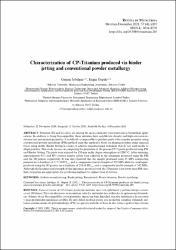Characterization of CP-Titanium produced via binder jetting and conventional powder metallurgy
Künye
İyibilgin, O., & Gepek, E. (2021). Characterization of CP-Titanium produced via binder jetting and conventional powder metallurgy. Revista de Metalurgia, 57(4).Özet
Titanium (Ti) and its alloys are among the most commonly used materials in biomedical applications. In addition to being biocompatible, these materials have notable low density and high corrosion resistance and mechanical properties. It is difficult or impossible to produce parts with complex geometry using conventional powder metallurgy (PM) method since this method is based on shaping powders under uniaxial forces using molds. Binder Jetting is a kind of additive manufacturing technique that do not need molds to shape powders. This study focuses on comparing the properties of the porous CP-Ti parts produced using PM and Binder Jetting. The parts were sintered for 120 min under Argon atmosphere at 1200 degrees C. After sintering, approximately 94% and 92% relative density values were achieved in the specimens produced using the PM and the 3D printer, respectively. It was also observed that the sample produced using 25 MPa compacting pressure has a hardness of 317 +/- 10 HV0.05 and a compressive (yield) strength of 928 MPa while its counterpart produced using the 3D printer has a hardness of 238 +/- 8 HV0.05 and a compressive (yield) strength of 342 MPa. Although the hardness and strength of the specimens produced with the 3D printer were lower than PM ones, their properties are appropriate for producing implants to replace bone structures.

















